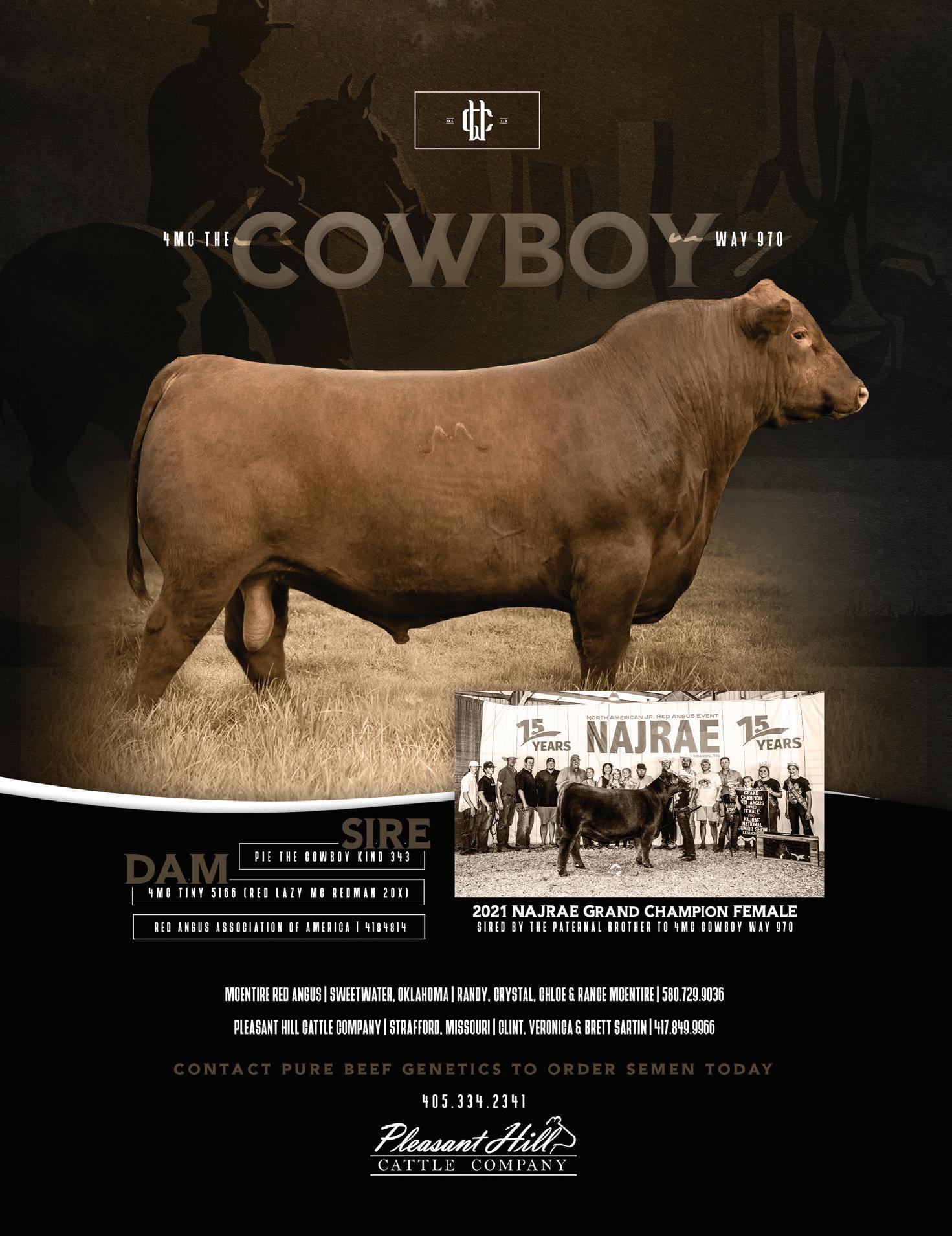
8 minute read
JRA Sponsors
As we kick off the new year of activities for the Junior Red Angus Association, we reflect on the past year and once again say thank you to our 2020-2021 sponsors. Their support made possible the virtual Young Stockman’s Program, the National Junior Show at the North American Junior Red Angus Event, national contests and JRA Round-Up throughout the Mid-South in Tennessee and Kentucky. Thank you for your support and investment in our youth.
DIAMOND SPONSORS

PLATINUM GOLD SILVER BRONZE
Hueftle Cattle Co. Milk Creek Reds
Green Mountain Red Angus Bieber Red Angus RA Brown Ranch
Rogers Cattle Co. LLC Heart River Ranch
JYJ Red Angus Lost Creek Red Angus Circle 5 Cow School
Devin & Katie Martin
Nolan & Kelly Woodruff Estrotect

The 2022 field day season may seem worlds away, but planning for a successful event for next summer starts now with reflection, goal setting and developing a strategic plan.
If your state hosted a field day this year, now is the time to evaluate what worked and what could be improved. It’s a good practice to write notes immediately as you plan for next year.
After determining what could be improved upon, take time to decide what you want your next field day to accomplish. “You need to decide what the purpose is,” said Annette Steffan, one of three junior advisers in North Dakota. “For example, should the field day be geared more toward the kids that show, or should you make it so all kids can come.
“We decided to organize our field day as an experience for kids that come from a registered or commercial background,” Steffan said. “Instead of focusing on the show end, we built on herd management, education and beef advocacy.”
Steffan and her fellow advisers aim to offer a well-rounded program with their field day. “We strive to develop kids who will stay in the breed and go on to serve on the board.” When planning their activities, she said it’s good to ask what activities are the kids involved in and if you can build on what they’re doing in 4-H, FFA, school or other activities. “I am hoping that we can take what they learn in school and take it to another level,” she continued.
In the past, North Dakota has hosted a two-day field day that included a show and a day of learning, but in 2021, the only option was a one-day educational event. The advisers decided to highlight a cook-off as the main attraction, but Steffan said the junior members really enjoyed an udder scoring demonstration and a cattle drive.
Leading up to the field day, four Zoom sessions covered Red Angus history, the life cycle of a beef animal, Beef Quality Assurance and beef nutrition as it relates to human diets. On the day of the field day, the cattle drive focused on what the youth had learned from the Zoom sessions.
As you develop your field day schedule, be sure to plan extra time throughout the day to catch up. Events always take longer than you think, plus speakers can talk longer than expected and it takes time if you have to move people throughout events.
Build Your Team
Planning a field day is a big responsibility for one person, so Steffan said it’s important to have help. In North Dakota, Steffan serves as the main adviser, but Shaye Koester handles educational components and Sara Lee coordinates shows.
“We work really well together and are able to pick up the pieces to make things work,” she said.
Beyond advisers, it’s a good idea to establish committees with clear responsibilities. Be sure to establish a chair person to keep the ball rolling on planning throughout the year. And, you may want to have a committee signup sheet at the registration table to find volunteers for the next year.
Find a Host
Once you have your goals in mind, an early project should be finding a suitable host. Steffan added that hosting a field day is an extra burden on the host family, so it’s important to have a clear understanding of what will be required, as well as how the other families can pitch in to help. You’ll also want to ensure the host can provide adequate meeting space, tents, show facilities, judging contest cattle or other activities.
“The host is critical,” Steffan said. “There’s a lot to facility preparation. You need to have a place where people can gather. If you have a show, you need an area to have the show or you’ll need to set up panels for a ring and show out of the trailer.”
Steffan stressed the importance of having adequate water for a show. She said the host needs to be prepared with items such as garbage cans, water, tables and bathroom facilities. In North Dakota, they also try to find a camping area nearby for added convenience for the families attending.
Brand Your Event
Once you do all this work, sing from the rooftops to make sure you have a crowd. Promote your event through means such as your website, social media and mailing or email lists. Be sure to include the adult association in your communications. If you’ll be attending shows or other ag events, hang flyers to get the word out. If any of your activities, such as judging contests and educational programs, are open to youth outside the breed, be sure to include 4-H and FFA leaders. (This can be a powerful opportunity to recruit new people to the breed.) If your location is near another state, invite junior members from that state too.
Use your ag network to help promote the field day as well. If other farm organizations have a calendar, social media or newsletter, ask if they would be willing to list your information. Notify Extension offices. If your state has an ag radio network, they might air an interview before the field day or even attend the event. Ask newspapers if they would send a photographer.
Consider a “save the date” announcement as soon as you know the initial details, then follow up with more information periodically as you get closer to deadlines and the event.
Steffan also recommends calling parents beforehand. “You have to call the parents to get the kids there.”A cookoff was the main attraction to attract juniors to the 2021 North Dakota Field Day. (Photos by Shaye Koester.)

Confirm Everything Before the Big Day
One month before the field day, plan a call with committee members to ensure tasks are being executed. Also, confirm that everything from the judges to the meal to the port-a-potties are still on track.
Develop a supply box ahead of time as well. Be sure to include items such as pens, paper, poster board, markers, scissors, tape, first-aid supplies, trash bags and name tags. If you have a judging contest, be sure to have plenty of pencils.
Finally, BreathE! It Will Be OK.
Things are going to go wrong, so you have to be as prepared as possible to react when it does. Don’t forget the field day is supposed to be fun and educational for the kids. Make sure it is for you, as the organizer, as well. As the day unfolds, keep reminding yourself that the end goal is building our youth for the future. As long as you stay true to your mission, your field day will be a great experience! Be sure to include hands-on activities for your field day. North Dakota youth built their perfect udder during an udder scoring demonstration.

Field Day checklist
One year to six months before field day 1. Evaluate past field day • What worked? • What didn’t work? 2. Goals • What do you hope to accomplish? • How will you achieve those goals? • What new ideas do you want to implement? 3. Obtain a host • Location • Time of year • Will facilities accommodate people/show? 4. Meet with host • Decide event date (Double check for possible conflicts with 4-H, FFA or related activities.) • Decide what the host will provide (meals, cattle for the judging contest, etc.) • When will the host need extra help? 5. Let technology assist you. Whether it’s a notepad app on your phone, an Excel spreadsheet or a yellow pad, find one system to record thoughts as you go and refer back to throughout the planning process.
Six to three months 1. Organize committees. Designate a chair person to be responsible for planning and execution. • Opening ceremonies • Program • Fundraising/sponsorship • Judging contest (choose judges with the host) • Awards, host and sponsor gifts • Registration (name tags, judging contest, etc.) • Meals, concessions, etc. • Decorations • Publicity • Contests • Special activities 2. Designate emcee 3. Finalize details for program and arrange printing.
Two months 1. Promotion • Radio, TV, local media and newspapers, livestock publications — arrange interviews beforehand. Some stations have free spots, but you have to ask first. • Mail/email program approximately four weeks before the first deadline stated in the program. • Contact 4-H and FFA groups • Finalize event judges • Lineup judging contest cards and official scorers • Order awards
One month 1. Assist host family (painting, repairs, cleanup, etc.) 2. Remind judges and other guests of date and responsibilities 3. Check the status of all committees 4. Locate a good, reliable P.A. system
Week before — arrive at field day location 1. Wash cattle 2. Set up corrals, bleachers and registration tables 3. Ensure bathrooms are available and clean 4. Signs 5. Backdrop for pictures 6. Have an officer/host meeting
After field day 1. Assist host with clean-up 2. Write thank you notes 3. Evaluate and make a summary of the event B&B










